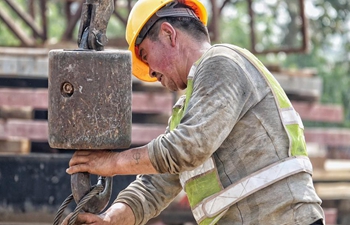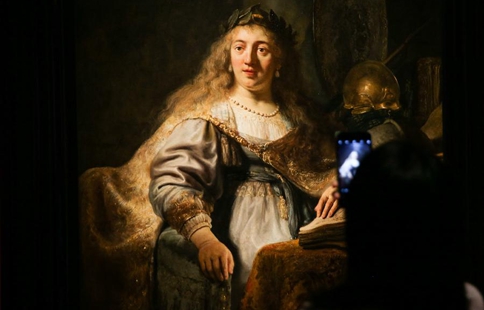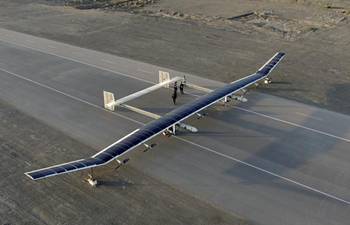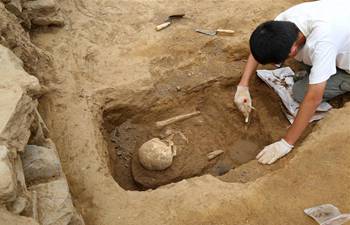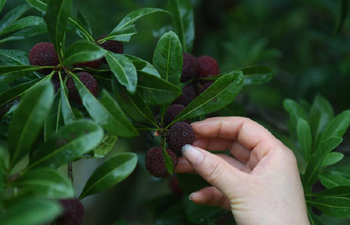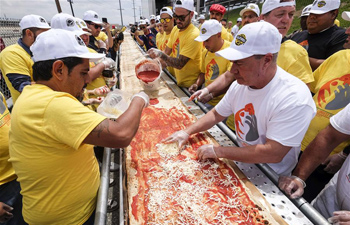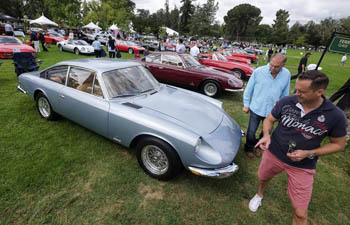
An Egyptian baker makes kunafa, a traditonal Egyptian dessert, by circularly pouring liquefied dough through a cup-shaped strainer onto the surface of the oven outside a large pastry store in Faisal district of Egypt's Giza province, June 15, 2017. Surviving over centuries, kunafa and qatayef are made of a mixture of flour, water, powdered milk and other materials. Customers of different ages, including men, women and children, buy kunafa and qatayef to cook them before sunset, the end of the fasting day, to enjoy them as desserts after the fast-breaking meal known among Muslims as iftar. (Xinhua/Ahmed Gomaa)
CAIRO, June 16 (Xinhua) -- In a sunny afternoon, dozens of customers were gathering outside a large pastry store in ever-crowded Malika Street in Faisal district of Egypt's Giza province, near the capital Cairo, to buy kunafa and qatayef which remain number one traditional desserts in Egypt during the Muslim holy month of Ramadan.
Surviving over centuries, kunafa and qatayef are made of a mixture of flour, water, powdered milk and other materials. They are baked by being poured on the drum-like surface of traditional round ovens before being sold to be cooked at home and soaked in sugary syrup.
At a corner of Zamzam bakery, Saeed Ahmed, a 59-year-old kunafa baker, was making raw kunafa by circularly pouring liquefied dough through a cup-shaped strainer onto the surface of the oven.
"Selling is booming during Ramadan. I would say that there is no home free from kunafa or qatayef during the holy month. Although we have handmade kunafa, machine-made kunafa is more popular here because it is free from human hands," the veteran kunafa baker told Xinhua.
Egypt has been suffering an economic crisis over the past few years because of political turmoil and related security issues that caused declining investments and tourism and increasing foreign and domestic debts, leading to price hikes in almost every commodity and service in the most populous Arab state.
"Everyone has been affected by the price hikes. The price of flour we use for making kunafa and qatayef tremendously increased. We still sell well, but demand has decreased compared to previous years due to rising prices," said Ahmed, adding that he has been working as a kunafa maker for about 50 years.
After being baked, kunafa looks more like noodles before it is cooked in a circular tray at home and the sweet syrup is added, while each piece of qatayef looks like a round flat dumpling which is later stuffed with dates, nuts, cheese or any other desirable materials, folded in half, fried in oil and then soaked in syrup.
Hajja Zainab, owner of Zamzam pastry store, said she inherited the profession from her father and grandfathers and she belongs to the fifth generation in her family working in this field.
"The industry greatly changed over the years. In the past, kunafa was completely handmade but now new generations prefer machine-made kunafa. This year, we introduced other flavors to raw kunafa like mango, orange, chocolate and margarine with milk," the lady told Xinhua at the store.
According to her, selling kunafa and qatayef is not such a seasonal thing restricted to Ramadan as many people think.
"We make them all through the year but they are more popular and saleable in Ramadan," Zainab said.
At the other side of the store, a crowd of customers of different ages, including men, women and children, were waiting for their turns to buy kunafa and qatayef to cook them before sunset, the end of the fasting day, to enjoy them as desserts after the fast-breaking meal known among Muslims as iftar.
Umm Khaled, a woman in her early 60s, said she prefers to buy raw kunafa and cook it at home rather than buying them readymade from pastry stores.
"Kunafa and qatayef are indispensable for Egyptian homes during Ramadan. I cook them very well at home. They date back to hundreds of years and I believe they will remain popular for hundreds of years to come. They will never vanish," she said outside the store.
Sirag-Eddin Anwar, 19, said he has been buying kunafa for several years, not only during Ramadan but throughout the year.
"I am a kunafa lover. I eat it whether in Ramadan or any other time of the year, but I buy it more during Ramadan," said the young man.
Despite the fact that Copts constitute a little more than 10 percent of the 94-million Muslim-majority population in Egypt, Christians also buy kunafa and qatayef and cook them at home during Ramadan.
"Kunafa and qatayef are Ramadanic features for all Egyptians. We as Christians buy and eat them. We live among Muslims and we enjoy good relations. We share their celebrations and buy relevant gifts and foods for our kids not to feel alienated," Girgis Saleh, a 52-year-old Copt, told Xinhua.





